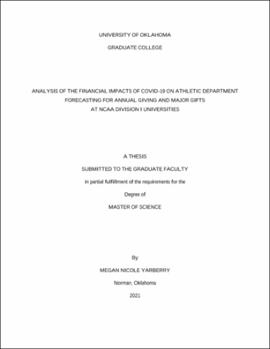| dc.description.abstract | There currently are no studies out there looking at financial forecasting for division I NCAA athletic department, in particular studies that look at the impact of a natural disaster and or “black swan” event that disrupts entire seasons overnight. The last dated disaster to affect college sports with similar impact was the Spanish Flu Pandemic in 1918. Purpose: The main purpose of this study is to report and note which financial processes were being used when generating revenue based on philanthropy and donation sector during COVID-19, with the hopes of helping future directors and practitioners make better planning decisions moving forward. Methods: 254 athletic programs were contacted between Division I – A and Division I – AA, and 41 completed surveys were collected, with at least one team from each conference represented. The survey allowed data collection on practices employed, from pre-COVID revenue generated and average gift sizes, to what actions were put in place during COVID, how they plan to change moving forward, and what might they think will happen for the 2021-2022 academic period.
Results: When managing and forecasting for the future, no particular group or division had statistically significant evidence to prove that one particular strategy was going to produce revenue generating concepts during a pandemic. With the addition of a natural disaster forecasting predictive element, schools that incorporated this within there forward thinking had a higher change of seeing either no change or an increase in revenue based on a philanthropic gift that is tax deductible. Conclusion: The findings to the study are limited in generalizability based on those programs that participated, but no two schools have similar strategies even coming from like backgrounds and conferences. Each school made decisions that best fit their needs, and donor/fan demographic & engagement. Based on preliminary pre-COVID results there are more commonly used strategies then others, but no one strategy emerged to be better than another. After descriptive analyses on grouped institution types (Power 5 v. Group of 5), no clear statistical evidence was found. | en_US |
